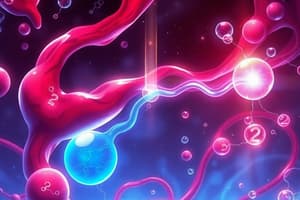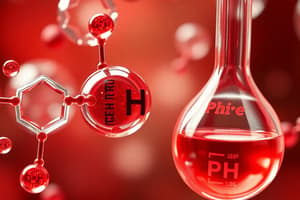Podcast
Questions and Answers
What serves as the major buffer of the blood around pH7?
What serves as the major buffer of the blood around pH7?
- Bicarbonate (correct)
- Sulfuric acid
- Hydrogen peroxide
- Carbon dioxide
In an acidic solution with excess (H+), which reaction is favored as part of the buffering system?
In an acidic solution with excess (H+), which reaction is favored as part of the buffering system?
- HCO3- + H+ ------> H2CO3 (correct)
- HCO3- + OH- ------> H2O + CO3^2-
- H2CO3 + H2O ------> H3O+ + HCO3-
- CO2 + H2O ------> H2CO3
What is the number of electrons in the outer orbital of a Carbon atom?
What is the number of electrons in the outer orbital of a Carbon atom?
- 8
- 2
- 4 (correct)
- 6
Which element can bond with the greatest number of other atoms compared to any other element?
Which element can bond with the greatest number of other atoms compared to any other element?
What term refers to atoms with the same atomic number but different numbers of neutrons?
What term refers to atoms with the same atomic number but different numbers of neutrons?
What is characteristic of ring structures formed by joining ends of some hydrocarbons?
What is characteristic of ring structures formed by joining ends of some hydrocarbons?
What is the general formula for polysaccharides?
What is the general formula for polysaccharides?
What is the main difference between inorganic and organic compounds?
What is the main difference between inorganic and organic compounds?
Which enzyme is required for the formation of sucrose?
Which enzyme is required for the formation of sucrose?
Which of the following is NOT an example of an inorganic compound?
Which of the following is NOT an example of an inorganic compound?
What is the main blood sugar among the following monosaccharides?
What is the main blood sugar among the following monosaccharides?
What function do buffers serve in blood pH regulation?
What function do buffers serve in blood pH regulation?
Which organic compound is characterized by NOT having a 2:1 ratio of hydrogen to oxygen?
Which organic compound is characterized by NOT having a 2:1 ratio of hydrogen to oxygen?
Which type of fats can be found in a 'saturated' form?
Which type of fats can be found in a 'saturated' form?
Which type of carbohydrate is formed by glucose and galactose?
Which type of carbohydrate is formed by glucose and galactose?
What is a common feature of organic molecules?
What is a common feature of organic molecules?
What is the primary purpose of excess carbohydrates in the body?
What is the primary purpose of excess carbohydrates in the body?
Which of the following is not an example of an inorganic compound?
Which of the following is not an example of an inorganic compound?
Flashcards are hidden until you start studying
Study Notes
Buffers and pH Regulation
- Bicarbonate serves as the major buffer of the blood, maintaining a pH around 7.
- When pH is low (acidic solution), the reaction HCO3- + H+ → H2CO3 is favored.
- When pH is high (basic solution), the reaction H2CO3 → HCO3- + H+ is favored.
Organic Molecules
- Many organic molecules are large and complex, held together by covalent bonds.
- Carbon has four electrons in its outer orbital, allowing it to bond with multiple atoms and form long chains.
- Four main classes of organic molecules exist.
Isotopes
- An isotope is an atom with the same atomic number but differing atomic mass due to varying numbers of neutrons.
Carbon Skeleton and Functional Groups
- A chain of carbon atoms in an organic molecule is called a carbon skeleton.
- Functional groups can be added to the carbon skeleton, and the molecule is named according to its functional group.
Ring Structures
- Ends of some hydrocarbons can be joined to form cyclic ring structures.
- Cyclic rings with double bonds between adjacent carbons form aromatic rings.
Functional Groups and Isomers
- Isomers can have the same atoms arranged in the same sequence but differ in 3-dimensional orientation of key functional groups.
Inorganic and Organic Compounds
- Compounds are substances containing atoms of two or more different elements.
- Two principle classes: inorganic and organic compounds.
- Inorganic compounds usually lack carbon, have simple structures, and cannot perform complex chemical reactions.
- Organic compounds always contain carbon, hydrogen, and covalent bonds.
Carbohydrates
- Carbohydrates supply energy and have structural functions.
- Examples include glucose, complex carbohydrates, glycoproteins, and glycolipids.
- Excess carbohydrates are converted to fat.
- Carbohydrates contain carbon, hydrogen, and oxygen in a ratio of (CH2O).
Monosaccharides, Disaccharides, and Polysaccharides
- Monosaccharides are simple sugars with 3-7 carbon atoms (e.g., glucose, galactose, fructose, deoxyribose, and ribose).
- Disaccharides are formed by two monosaccharides joined covalently (e.g., sucrose, maltose, and lactose).
- Polysaccharides are composed of many monosaccharides joined covalently (e.g., starch, cellulose, and glycogen).
Lipids
- Lipids are the second most important organic compound found in the body, making up 18-25% of body mass.
- Lipids contain carbon, hydrogen, and oxygen but do not have a 2:1 ratio of hydrogen to oxygen.
- There are several different types of lipids, including saturated, monounsaturated, and polyunsaturated fats, which differ in chemical structure.
Studying That Suits You
Use AI to generate personalized quizzes and flashcards to suit your learning preferences.




